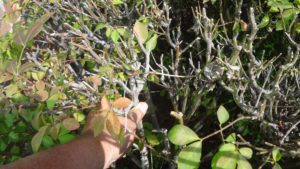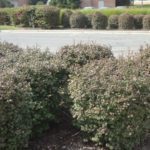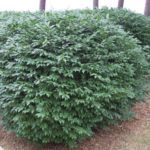By Joe Ketterer, Director of Quality and Efficiency, Maintenance Division
 Dormant pruning is done to improve plant health and/or reduce the size of existing plantings that may have become overgrown since their initial planting. When properly timed and executed, dormant pruning will maintain the natural shape and growth habits of the shrub with respect to its flowering, fruiting and foliage characteristics.
Dormant pruning is done to improve plant health and/or reduce the size of existing plantings that may have become overgrown since their initial planting. When properly timed and executed, dormant pruning will maintain the natural shape and growth habits of the shrub with respect to its flowering, fruiting and foliage characteristics.
 Pictured right: Spider mite damage is especially common among sheared and tightly pruned plants, and they can decimate the leaves. Dormant pruning will often eliminate this problem and make the plant more hospitable to beneficial insects such as ladybugs.
Pictured right: Spider mite damage is especially common among sheared and tightly pruned plants, and they can decimate the leaves. Dormant pruning will often eliminate this problem and make the plant more hospitable to beneficial insects such as ladybugs.
All too often, many flowering plants are sheared repeatedly during the course of the growing season, preventing them from showing off the very attributes for which they were planted in the first place. We need to stop this horticulturally incorrect practice that is all too common within the industry/marketplace just because it appears to be faster and more economical. While shearing of some evergreens has its place with respect to maintaining a formal manicured hedge, we need to recognize that it actually can cost more in the long run with respect to total labor costs expended over the course of the entire season or contract year. More education regarding plant culture is needed for our own team members as well as our customers about the value of dormant pruning. As we prepare for the 2017 dormant pruning season (January through March), it is important to understand why we are doing this and what it means for our customer, the company, and the overall health and appearance of the plant.
 Pictured right: Crow’s feet is an excessive flush of growth caused by a single cut resulting in three to five new small stems.
Pictured right: Crow’s feet is an excessive flush of growth caused by a single cut resulting in three to five new small stems.
Benefits of Dormant Pruning for the Customer:
- Increases the aesthetic and ornamental value of existing plant material. This could include improved flowering, fruiting, foliage and general growth habit or plant shape.
- Improves the overall appearance of the site with more natural looking plants that perform better horticulturally
- Can potentially reduce maintenance costs over time and preserve the integrity of the original design while keeping property values up
- Improves plant health by reducing certain pest populations
Benefits of Dormant Pruning for the Company:
- Reduces overall pruning hours for the entire season by reducing growth flushes and crow’s feet
- Reduces our workload in the summer : Dormant pruning can significantly reduce summer pruning needs, as long as we don’t “undo” the good work that we did in the first quarter with indiscriminate or severe shearing, which in turn negates the horticultural benefits of dormant pruning and applied growth regulators by actually encouraging flush growth as a response to severe shearing.
- Improves our reputation and image by implementing more horticulturally correct methods
- Creates enhancement sales opportunities
 Euonymous Alatus Compacta (Burning Bush) when it’s been sheared (left), makes the plant more susceptible to mites.
Euonymous Alatus Compacta (Burning Bush) when it’s been sheared (left), makes the plant more susceptible to mites.
 Euonymous Alatus Compacta (Burning Bush) when it’s been dormant pruned (right), allows for beneficial insects to thrive.
Euonymous Alatus Compacta (Burning Bush) when it’s been dormant pruned (right), allows for beneficial insects to thrive.
It is important to note that not all shrub species require dormant pruning, and not all can be dormant pruned to the same extent or at the same time, as some are more sensitive to cold and severity of pruning. Not all plants are created equal and therefore should not be treated equally. The ability to identify plants is paramount to the success of dormant pruning.
The following species of plants offer the highest gains if properly dormant pruned:
- Euonymus sp. (Manhattan and Burning Bush)
- Hollies sp. (Chinese, Japanese, Inkberry, Winterberry)
- Roses sp. (Knockout and Carpet Roses)
- Barberry sp. (Crimson Pygmy and Julianne)
- Viburnum sp. (Korean Spice, Dentatum, Burkwoodi, etc.)
- Hydrangeas sp. (Paniculata, Macrophylla, Oakleaf, etc.)
- Spireas sp. and Abelia (most summer flowering shrubs)
Knowledge is Power…look for three training modules on dormant pruning to be posted in the Learning Management System (LMS) soon!